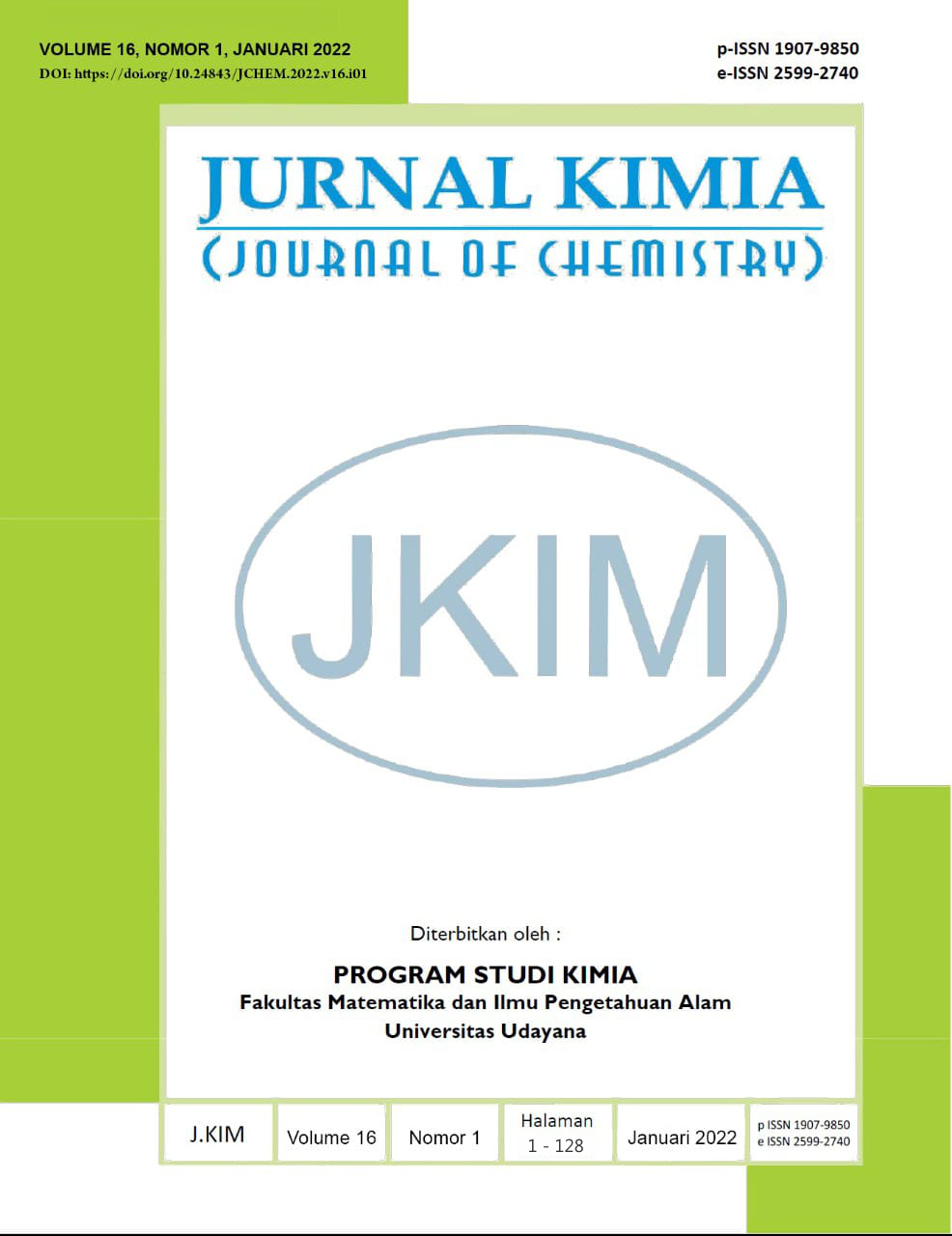REVIEW: POTENSI TANAMAN MARIGOLD (Tagetes erecta ) SEBAGAI FITOREMEDIATOR
Abstract
Fitoremediasi adalah salah satu tehnik alternatif dalam usaha pemulihan lingkungan tanah, air maupun udara yang telah tercemar oleh berbagai macam polutan menggunakan tanaman hijau dalam keadaan hidup. Tujuan dari penulisan paper ini adalah untuk memberikan gambaran yang komprehensif mengenai pemanfatan tanaman marigold spesies Tagetes erecta sebagai suatu fitoremediator. Metode yang digunakan untuk mengumpulkan dan menelaah bahan review adalah studi literatur yang sistematis dari berbagai sumber, diantaranya researchgate, google schoolar, sciensedirect serta sumber lainnya. Dari telaah yang telah dilakukan dapat diketahui bahwa tanaman Tagetes erecta dapat digunakan sebagai fitoremediator lingkungan yang tercemar berbagai macam polutan.
Kata kunci: fitoremediator, marigold, Tagetes erecta.
Phytoremediation is an alternative technique which is used to restore the soil, water as well as the air contaminated by heavy metals and other pollutants using live green plants. The purpose of the writing of this paper is to provide a comprehensive picture of the use of marigold plant species of Tagetes erecta as a phytoremediator. The method applied to collect and review the materials was a systematic literature study using various sources, including researchgate, google schoolar, sciencedirect and other sources. From the study carried out, it can be seen that Tagetes erecta can be used as a phytoremediator in an environment contaminated with various pollutants.
Keywords: marigold, phytoremediator, Tagetes erecta.
Downloads
References
Bardiya-Bhurat, K., Sharma, S., Mishra, Y., and Patankar, C. 2017. Tagetes erecta (marigold), a phytoremediant for Ni- and Pb-contaminated area: a hydroponic analysis and factors Involved. Rend. Fis. Acc. Diakses 6 Desember 2021 dari URL: https://www.researchgate.net/ publication/319251839_Tagetes_erecta_marigold_a_phytoremediant_for_Ni-_and_Pb-contaminated_area_a_ hydroponic_analysis_and_factors_involved.
Bosiacki, M. 2009. Phytoextraction of Cadmium and Lead by Selected Cultivars of Tagetes erecta L. Part II. Contents of Cd and Pb in Plants. Acta Sci. Pol., Hortorum Cultus. 8 (2): 15-26.
Babli, Kaur, C., Singh V. P. and Srivastava, A. 2021. Electric Current: A Better Alternate Compared to EDTA in Rapid Accumulation of Heavy Metal in Tagetes erecta. Plant Archives. 21(1): 2323-2327
Bosiacki, M. and Wojciechowska, E. 2012. Phytoextraction of Nickel by Selected Ornamental Plants. Ecol Chem Eng S.; 19(3): 331-345.
Capuana, M. 2020. A review of the performance of woody and herbaceous ornamental plants for phytoremediation in urban areas, IForest, 13:139-151.
Carrera, O. and Tello, L. 2020. Lead Phyto extraction in the Huachipa Zoological Park through the use of Tagetes erecta associated with a mycorrhiza and EDTA. Peruvian Journal of Agronomy. 4(1): 27-34.
Castillo, O.S., Dasgupta-Schubert, N., Alvarado, C.J., Zaragoza E.M., and Villegas, H.J. 2011.The effect of the symbiosis between Tagetes erecta L. (marigold) and Glomus intraradices in the uptake of Copper(II), New Biotechnology, 1(29): 156-164.
Chitraprabha, K. and Sathyavathi, S. 2018. Phytoextraction of chromium from electroplating effluent by Tagetes erecta (L.). Sustainable Environment Research. 28: 128-134.
Coelho, L. C., Bastos, A. R. R., Pinho, P. J., Souza, G. A., Carvalho, J. G., Coelho, V. A. T., Oliveira, L. C. A., Domingues, R. R., and and Faquin, V. 2017. Marigold (Tagetes erecta): The Potential Value in the Phytoremediation of Chromium. Pedosphere 27(3): 559–568.
Das, S., Goswami, S., and Talukdar, A. D. 2013. Copper Hyperaccumulating Plants From Barak Valley, South Assam. India For Phytoremediation. International Journal of Toxicological and Pharmacological Research. 5(1): 30-32.
Esringü, A., Turan, M., and Cangönül, A. 2021. Remediation of Pb and Cd Polluted Soils with Fulvic Acid. Forests. 12. 1608.
Gupta, P. and Vasudeva, N. 2012. Marigold A Potential Ornamental Plant Drug. Hamdard Medicus. 55(1): 45-59.
Kaur, N., Kaushal, J., Mahajan, P., Srivastav, A. L. 2021. Screening of Plant Species for Phytoremediation of Synthetic Textile Dye Wastewater, Research Square: 1-17; Diakses 6 Desember 2021 dari URL: https://assets.researchsquare.com/files/rs-61075/v6/8b749820-be85-4179-9cad-6ea9b66eaed0.pdf?c=1631885319
Lersel, M. W. van. 2006. Respiratory Q10 of Marigold (Tagetes patula) in Response to Long-Term Temperature Differences and Its Realtionship to Growth and Maintenance Respiration. Physiologia Plantarum. 128: 289-301.
Li-wei, X., Juan, C., Huan-yang, Q. I., and Yan-ping, S. H. I. 2012. Phytochemicals and Their Biological Activities of Plants in Tagetes L. Chinese Herbal Medicines, 4(2): 103-117.
Priyanka, D., T. Shalini, and V. K. Navneet. 2013. A Brief Study on Marigold (Tagetes Species): A Review. International Research Journal of Pharmacy. 4(1): 43-48.
Safitri, F. D., Lukiwati, D.R., dan Mansur I. 2020. Inokulasi berbagai spesies cendawan mikoriza arbuskular (CMA) terhadap pertumbuhan dan kemampuan akumulasi logam Pb pada tanaman marigold (Tagetes erecta L.). J. Agro Complex 4(1):60-68.
Sathya, V., Mahimairaja, S., Bharani, A., and Krishnaveni, A. 2019. Influence of Soil Bioamendments on the Availabilty of Nickel and Phytoextraction Capability of Marigold from the Contaminated Soil. International Journal of Plant & Soil Science. 31(5): 1-12.
Saxena, P. and Sonwani, S. 2020. Remediation of Ozone Pollution by Ornamental Plants in Indoor Environment. Global J. Environ. Sci. Manage. 6(4): 497-508.
Siaka, I M., Febriyanti, N. P. D., Sahara, E., and Negara, I M. S. 2016. Pembuatan dan Karakterisasi Arang Aktif dari Batang Tanaman Gumitir (Tagetes erecta) pada Berbagai Suhu dan Waktu Pirolisis. Cakra Kimia (Indonesian EJournal of Applied Chemistry). 4(2): 168-177.
Vijayan, V. D. and Sushama, P. K. 2018. Phytoremediation as an Effective Technology for the Removal of Heavy Metals from Dump Yard Soils. Nature Environment and Pollution Technology. 17(4): 1353-1358.
Vangronsveld, J., Weyens, N., Thijs, S., Dubin, D., Clemmens, M., Van Geert, K., Van Den Eeckhaut, M., Van den Bossche, P, Van Gestel, G., Bruneel, N., Crauwels, L., and Lemmens, C. 2019. Phytoremediation – Code of Good Practice. Report. OVAM: 6-14.
Yokoyama, S. 2008. Asian Biomass Handbook. A Guide for Biomass Production and Utilization. Japan: The Japan Institute of Energy.

This work is licensed under a Creative Commons Attribution 4.0 International License






